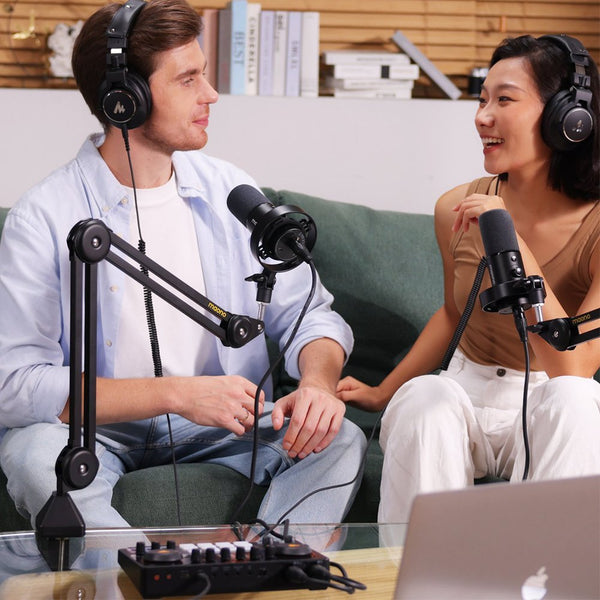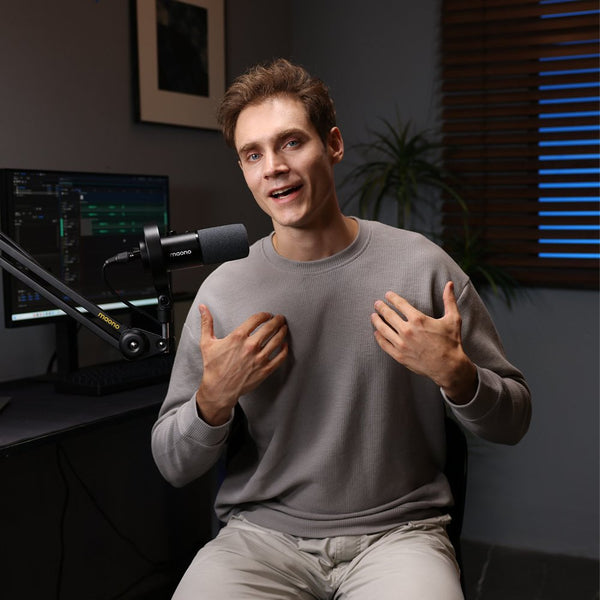Whether you're dreaming of performing on stage, improving your speaking voice, or simply singing in tune, voice lessons can unlock your full vocal potential. A professional instructor doesn’t just teach you how to sing—they help you understand how your voice works and guide you through vocal exercises tailored to your goals and abilities. Whether you're singing in a studio or using a singing microphone at home for online lessons, proper technique is key to getting the best sound. Choosing the right equipment, such as a professional microphone for singing or a quality USB microphone, can greatly enhance your vocal clarity and presence.
In this guide, we’ll explore what’s typically taught in voice lessons, what to expect as a beginner, key techniques for vocal development, and how to get the most out of your training.
Fundamentals of What’s Taught in Voice Lessons
Voice lessons cover a wide range of skills including pitch control, breath support, vocal tone, diction, and stage presence. Whether your goal is to become a confident performer or simply refine your natural abilities, vocal training helps strengthen the muscles responsible for singing and speaking clearly. Lessons can be customized based on age, experience, genre preference, and vocal goals. With the support of the right microphone for singing at home, your instructor will be able to clearly hear your progress during virtual sessions.
Beginner Expectations: Your First Voice Lesson Explained
Your first voice lesson usually involves a vocal assessment. The instructor will ask about your goals and experience, then listen to you sing a scale or simple song to evaluate your pitch, tone, and range. This helps them customize exercises and techniques suited to your level.
Expect to learn basic breathing techniques, posture correction, and simple warm-up routines. Don’t worry about being perfect—your instructor is there to guide, not judge. If you're recording your progress, using a recording microphone can help you track improvements over time.
How Voice Lessons Improve Singing and Speaking
Voice lessons don’t only benefit singers. They also help speakers, actors, podcasters, and professionals who rely on vocal clarity. Proper breath control and vocal resonance can make your voice more engaging, expressive, and sustainable over long periods.
Singing lessons also improve enunciation, volume control, emotional delivery, and even self-confidence. Over time, you’ll notice a smoother tone, stronger projection, and better control over your vocal cords. A professional microphone singing setup can help bring out these qualities in your recordings or online sessions.
Techniques Vocal Coaches Use to Improve Tone and Range
Voice instructors use a variety of techniques to help students improve:
-
Vocal exercises like scales and arpeggios build muscle memory and expand vocal range.
-
Resonance training helps you learn how to place your voice for a richer tone.
-
Pitch-matching drills improve your ear and intonation.
-
Singing with dynamics teaches you to control volume and emotion.
With consistency, you’ll be able to sing more comfortably across low and high registers while maintaining vocal health.
Why Breathing and Posture Are Central to Vocal Training
One of the first things every voice teacher addresses is breath control. Singing from the diaphragm provides power and stability. Breathing exercises help build lung capacity and support sustained vocal phrases without strain.
Good posture also plays a vital role. Standing tall with a relaxed neck and open chest allows air to move freely and prevents vocal tension. Voice lessons consistently reinforce these physical fundamentals to ensure vocal longevity and prevent injury.
What to Look for in a Good Voice Instructor
A great voice instructor will:
-
Understand vocal anatomy and safe singing techniques.
-
Customize lessons to your learning style and goals.
-
Provide constructive feedback without discouragement.
-
Have experience with your preferred genre (pop, classical, jazz, etc.).
-
Offer a structured yet flexible learning plan.
Whether in person or online, communication and trust are key. A teacher who inspires you will help you progress faster and stay motivated.
Progress Timeline: How Long It Takes to See Vocal Improvement
Every voice is different, so progress timelines vary. Most students see small improvements in breath control, tone, and pitch after a few weeks of consistent practice.
-
1–3 months: Noticeable control and confidence.
-
3–6 months: Expanded vocal range, improved tone, and better technique.
-
6–12 months+: Solid foundation, potential for performance readiness.
Daily practice (even 15–30 minutes) makes a big difference. Remember, vocal development is a marathon, not a sprint.
FAQ Section
What exactly do vocal instructors teach during voice lessons?
Instructors teach breathing, pitch, tone, diction, warm-ups, performance skills, and genre-specific techniques.
Do you have to know how to sing before starting voice lessons?
No. Lessons are for all levels—from absolute beginners to advanced performers.
What’s the difference between vocal coaching and voice lessons?
Voice lessons build technique; vocal coaching focuses on performance and interpretation, often for advanced singers.
Why is breath control so important in singing?
It supports sustained notes, vocal strength, tone control, and protects your vocal cords from strain.
How do voice teachers help improve vocal range?
Through consistent warm-ups, vocal exercises, and proper placement techniques.
What kind of warm-up exercises are usually included?
Lip trills, humming, sirens, scales, and arpeggios tailored to your vocal range.
How does posture affect your singing voice?
Good posture supports diaphragmatic breathing and prevents neck/throat tension.
Can voice lessons help with speaking confidence too?
Absolutely. Voice training enhances speech clarity, projection, and confidence.
What does a typical 1-hour voice lesson include?
Breathing drills, vocal warm-ups, song work, feedback, and homework assignments.
Do vocal coaches teach different techniques for pop vs. classical?
Yes. Classical emphasizes head voice and control; pop focuses more on stylization and mix voice.
How do instructors tailor lessons for beginners versus advanced students?
Beginners focus on foundational technique; advanced students work on artistry, repertoire, and stage presence.
Will I learn to read music in voice lessons?
Some teachers include music theory and sight-singing; others focus on ear training and interpretation.
How long does it take to improve my singing voice?
Expect noticeable progress within 1–3 months with regular lessons and daily practice.
Can voice lessons really fix a “bad” singing voice?
Yes—many people improve dramatically with technique, patience, and guidance.
How often should I practice between lessons?
Aim for at least 4–5 days per week, 15–30 minutes per session, to build vocal strength.
What equipment or tools do I need for online voice lessons?
A reliable internet connection, good webcam, piano app or keyboard, and a quality microphone.
Recommended: Best Mics for Singing in Online Lessons
For optimal sound quality during virtual voice lessons, a condenser microphone is the best choice. Two standout models ideal for singing include:
1. Maono PM450 USB Condenser Microphone

-
Features:
-
Cardioid pickup pattern for focused sound capture
-
High-resolution 48kHz/24 bit recording
-
Comes with a boom arm, shock mount, pop filter, and windscreen
-
Why it’s great:
The Maono PM450 delivers crisp, studio-quality vocals at an affordable price. Its sensitivity and clarity make it ideal for vocal lessons, recording microphone needs, or streaming music content. It’s a top choice for those looking for a reliable professional microphone singing setup at home.
2. Maono A04 USB Condenser Microphone

-
Features:
-
Plug-and-play USB connectivity
-
Smooth frequency response (30Hz–16kHz)
-
Complete kit with stand and pop filter
-
Why it’s great:
The Maono A04 is a user-friendly choice for beginners. Its consistent vocal clarity and minimal setup make it perfect for online students, especially those using a microphone for singing at home for lessons and practice.
How much do professional voice lessons usually cost?
Rates vary by region and instructor experience. Expect to pay:
-
$30–$60 per hour for beginner to intermediate teachers
-
$60–$120+ per hour for professional vocal coaches or specialists
Some teachers also offer discounted monthly packages or online group sessions.
What should I do to prepare before my first voice lesson?
-
Stay hydrated
-
Avoid caffeine or dairy right before singing
-
Warm up lightly if you’ve sung before
-
Bring any song you enjoy or are comfortable with
-
Be ready to listen and try new things—it’s a learning experience!
Conclusion
Voice lessons are a powerful way to explore and strengthen your natural voice—whether you're singing your heart out, presenting with confidence, or creating content online. From breathing and posture to vocal technique and musical interpretation, you’ll gain tools that support both performance and personal growth.
With a quality USB microphone like the Maono PM450 or A04, you’ll ensure your teacher hears your best sound during virtual sessions. These mics also serve as excellent professional microphones for singing and content creation. And remember: progress comes with consistency, patience, and the right guidance. So breathe deep, sing proud, and let your voice shine.
Related Article:
Singing Tips and XLR Microphone Guide: Improve Vocals at Home



